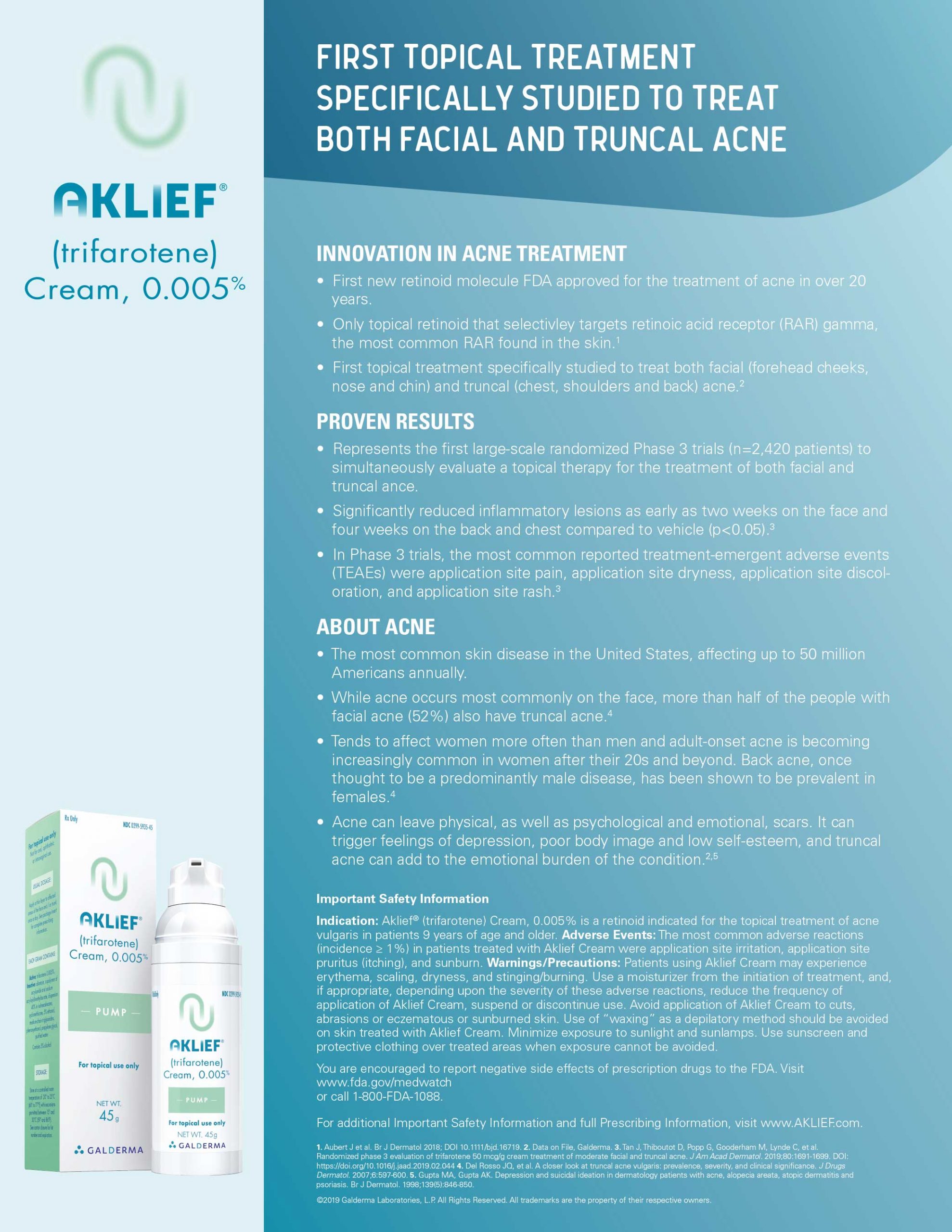
Annals of Pharmacotherapy, Ahead of Print.
Objective: This article reviews clinical trials to assess the efficacy, safety, and clinical application of trifarotene 0.005% cream (Aklief). Data Sources: A systematic review of the literature was performed using the terms trifarotene OR Aklief OR CD5789 in MEDLINE (PubMed) and EMBASE databases. Articles prior to May 2020 were considered for inclusion. Bibliographies and ClinicalTrials.gov were also searched to identify further studies. Study Selection and Data Extraction: Relevant English language and human studies related to pharmacology, clinical trials, and safety were considered. Data Synthesis: In the 52-week phase III trial, treatment success rates for facial acne (Investigator Global Assessment [IGA] rating of no or almost no acne) and truncal acne (Physician’s Global Assessment [PGA] rating of no or almost no acne) were 65.1% and 66.9%, respectively. Overall success rates (IGA and PGA success in the same patient) were 57.9%; 52.8% of patients had a Dermatology Quality of Life Index score of 0 or 1, compared with 22.6% at baseline. Trifarotene was well tolerated, with pruritus, irritation, and sunburn as the most common adverse effects. Relevance to Patient Care and Clinical Practice: Trifarotene is a newly Food and Drug Administration–labeled fourth-generation topical retinoid that shows particular promise in the treatment of facial and truncal acne vulgaris. It is an effective and safe addition to currently available retinoids. Conclusion: Trifarotene is effective and safe for treatment of facial and truncal acne. Future trials should compare its efficacy and tolerability with that of the older, clinically established retinoids. Despite efficacy, cost may be a prohibitive factor.
Objective: This article reviews clinical trials to assess the efficacy, safety, and clinical application of trifarotene 0.005% cream (Aklief). Data Sources: A systematic review of the literature was performed using the terms trifarotene OR Aklief OR CD5789 in MEDLINE (PubMed) and EMBASE databases. Articles prior to May 2020 were considered for inclusion. Bibliographies and ClinicalTrials.gov were also searched to identify further studies. Study Selection and Data Extraction: Relevant English language and human studies related to pharmacology, clinical trials, and safety were considered. Data Synthesis: In the 52-week phase III trial, treatment success rates for facial acne (Investigator Global Assessment [IGA] rating of no or almost no acne) and truncal acne (Physician’s Global Assessment [PGA] rating of no or almost no acne) were 65.1% and 66.9%, respectively. Overall success rates (IGA and PGA success in the same patient) were 57.9%; 52.8% of patients had a Dermatology Quality of Life Index score of 0 or 1, compared with 22.6% at baseline. Trifarotene was well tolerated, with pruritus, irritation, and sunburn as the most common adverse effects. Relevance to Patient Care and Clinical Practice: Trifarotene is a newly Food and Drug Administration–labeled fourth-generation topical retinoid that shows particular promise in the treatment of facial and truncal acne vulgaris. It is an effective and safe addition to currently available retinoids. Conclusion: Trifarotene is effective and safe for treatment of facial and truncal acne. Future trials should compare its efficacy and tolerability with that of the older, clinically established retinoids. Despite efficacy, cost may be a prohibitive factor.
